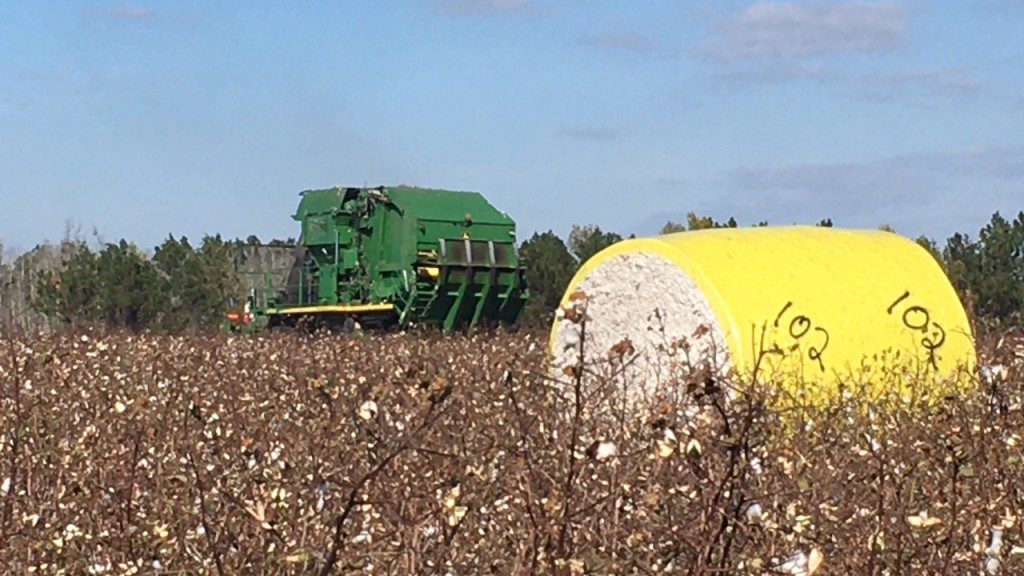Cotton
-
Below are various questions I received this week. They include forage moisture, weed control in corn and cotton, and Aspergillus crown rot. Also during the last couple of weeks we planted a few on farm corn demonstrations. What should my forage moisture be for baled silage? Considering all factors, the optimum whole-plant moisture for baled…
-
The UGA Cotton newsletter is now posted on the UGA Cotton Team website and is available here: https://www.ugacotton.com/vault/file/April-2021-Newsletter.pdf. Articles in this month’s issue include: Using Pesticides Wisely 2021 and Paraquat Training Update (Stanley Culpepper, UGA and JesseKelly and Jennifer Wren, GDA) Considerations for Peak Planter Performance (Simer Virk and Wesley Porter) Early season disease and…
Posted in: Cotton -
The 2021 UGA Virtual Cotton Production Meeting is offered below. This meeting has been broken down into individual presenters and their presentations which are all offered below. Taylor Sills shares Georgia Cotton Commission Update Choosing which variety to plant is one of the most critical steps in producing a cotton crop and achieving optimal yields…
Posted in: Cotton -
In this issue: Current SituationOat Disease Situation2021 Using Pesticide Wisely Trainings2021 Spray Application Equipment and Technology SurveyNew Paraquat Training RequirementsWhat about using sulfur in peanut fungicide programs??Why seasonal climate forecasts aren’t always accurate? By Pam KnowHow do I fertilize my home pecansTifton Bull TestUGA Cover Crop Research Survey Current Situation: It has been a drier…
-
Hello, Information about Using Pesticide Wisely Trainings have just been released and is discussed below. The announcement about the UPW trainings can be obtained Below. AUXIN TRAINING REQUIREMENTS – GEORGIA 2021 Engenia, FeXapan, Tavium, XtendiMax All applicators driving the tractor/sprayer applying these herbicides must attend Using Pesticides Wisely during 2021 prior to using these products! …
-
Southern rootknot nematodes has been a challenge for Colquitt County cotton producers. According to Dr. Bob Kemerait, UGA Plant Pathologist, an estimated 60 to 70 percent of Georgia’s cotton fields are infested with at least one species of damaging nematodes. In a recent statewide survey of cotton fields (nearly 1800 samples were submitted by agents…
-
We had a great opportunity to conduct another on farm research trial at the Sunbelt Ag Expo in 2020. This research focused on the management of root knot nematodes in cotton. The plots were planted on May 14, 2020 and harvested on November 10, 2020. The treatments were replicated three times and each plot consisted…
-
The last few years I have had the great opportunity to work with Mr. Gene Hart, Colquitt County Young Farmer Advisor with various on farm research projects at the Packer Park Farm in Colquitt County. The research in 2020 focused on the management of root knot nematodes in cotton. This irrigated plot was planted on…
-
The last couple of years I have received questions about Areolate mildew and how to manage this disease in cotton. Areolate mildew, is caused by the fungal pathogen Ramularia areola. According to Dr. Bob Kemerait, UGA Plant Pathologist, this disease has become more widespread since 2017. The use of fungicides to protect against this disease…
Posted in: Cotton -
Choosing which variety to plant is one of the most critical steps in producing a cotton crop and achieving optimal yields and fiber quality. Below are results of the Preliminary 2020 On Farm Cotton Variety trials.
Posted in: Cotton
